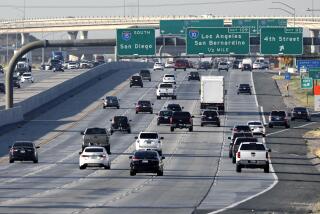Coast-to-Coast Highway May Be Nation’s Most Underappreciated Road : Travel: The roadway is a trek through the middle of America where, in many parts, time has stood still, its biographer says.
OCEAN CITY, Md. — Travelers leaving this beach resort pass under a sign on U.S. 50 that reads “Sacramento CA 3,073.” Some drivers never have noticed. Others think it’s a joke.
The reality is that Ocean City is the end of the road for Highway 50, as it’s affectionately known by those who study it, those who seriously travel it and those who just plain love it.
At the other end, or exactly 3,038 miles later, according to the Federal Highway Administration (hey, signs can be wrong), is Sacramento.
One might say “so what?” And therein lies the problem: U.S. 50 is a national highway that just can’t get no respect.
“I think it’s the most historic coast-to-coast route in the United States and the most underappreciated road in the country,” said Jim Lilliefors, editor of the weekly Maryland Coast Dispatch in nearby Berlin, Md.
Lilliefors, who spent three years traveling the two-lane road off and on, has written a book called “Highway 50” that will be published next spring.
The highway is a trek through the middle of America where, in many parts, time has stood still, Lilliefors said.
“There’s a way of life that has not changed a whole lot,” he said. “There are still people in Kansas whose ambition it is to grow up and own their own farm. You wouldn’t know it watching television, but there are still people out there with old-fashioned values.”
“It’s the heartland of America. The Main Street of America is on Highway 50,” said Doyle Davidson of LaJunta, Colo., executive vice president of the National Highway 50 Federation, a group dedicated to promoting the road.
U.S. 50 cuts through 12 states and the District of Columbia with scenery ranging from the beach in Ocean City to the national monuments in Washington to the wheat fields of Kansas, across the Continental Divide to Lake Tahoe and into California.
Lilliefors said he found a sense of humor and imagination in the small towns along the highway.
Winchester, Va., for example, contends that it’s the apple capital of the world--but so do four or five other towns.
“You go through these little towns and they have their claim to fame and it’s slightly exaggerated,” he said.
He recalled the “tall tales” he heard along the way, particularly in the West. One of the great storytellers was Dale Northern, the mayor of Dodge City, Kan., where U.S. 50 is named Wyatt Earp Boulevard.
“He was a character,” Lilliefors said. “He was a car salesman and decided he wanted to start selling Dodge City, so he became mayor.”
Lilliefors remembered Lee Cooley in Austin, Nev.--the only live entertainment in town. Accompanying himself on his accordion, Cooley would sing timeless favorites like “On Top of Old Smokey” and “The Streets of Laredo.”
And then there was the colorful Harley Warrick in Belmont, Ohio, who’s been painting “Chew Mail Pouch Tobacco” on the sides of barns since the 1940s.
“He’s kind of been adopted as a part of Americana,” Lilliefors said.
Warrick used the word “progress” with disdain and talked much “about the virtues of doing the same thing over and over,” Lilliefors said.
That theme was echoed by a man in Cimarron, Colo., who was convinced the nation had been going downhill since President John F. Kennedy was assassinated.
“There is a kind of a rebellion on America’s Main Street. . . . They don’t like it. They think the old ways work by and large,” Lilliefors said.
An Amish man in Kansas lamented about how awful it was that astronauts walked on the moon. In Kanosh, Utah, a Ute Indian who hunted and sold animal hides talked about how he didn’t have any skills.
Once Lilliefors finished his travels, “I felt like I’d learned a lot and thought most people don’t take the time to travel the small roads and they miss the whole story,” he said.
Davidson speculated that one reason Highway 50 doesn’t get the attention it deserves is because it parallels Interstate 70.
“When you have a four-lane highway paralleling a two-lane highway, generally speaking, the four-lane highway is going to get most of the traffic,” said Davidson, who has traveled the highway coast to coast about 40 times.
“But people who want to see the country and take their time and view America, they can do it better on Highway 50,” he said.
Another factor contributing to the highway’s lack of attention is U.S. 40, said Richard Weingroff, information liaison specialist with the highway administration.
“In doing research on it, I found that it took a back seat to U.S. 40,” Weingroff said. “Throughout its history, U.S. 40 was the dominant transcontinental route. . . . The things that happened on U.S. 50, many of which are quite historic, just didn’t capture the public’s imagination.”
Lilliefors hopes his book will change that.
Traveling Highway 50, he said, is a chance to gain “an understanding of the country and the history.”
More to Read
Sign up for The Wild
We’ll help you find the best places to hike, bike and run, as well as the perfect silent spots for meditation and yoga.
You may occasionally receive promotional content from the Los Angeles Times.






